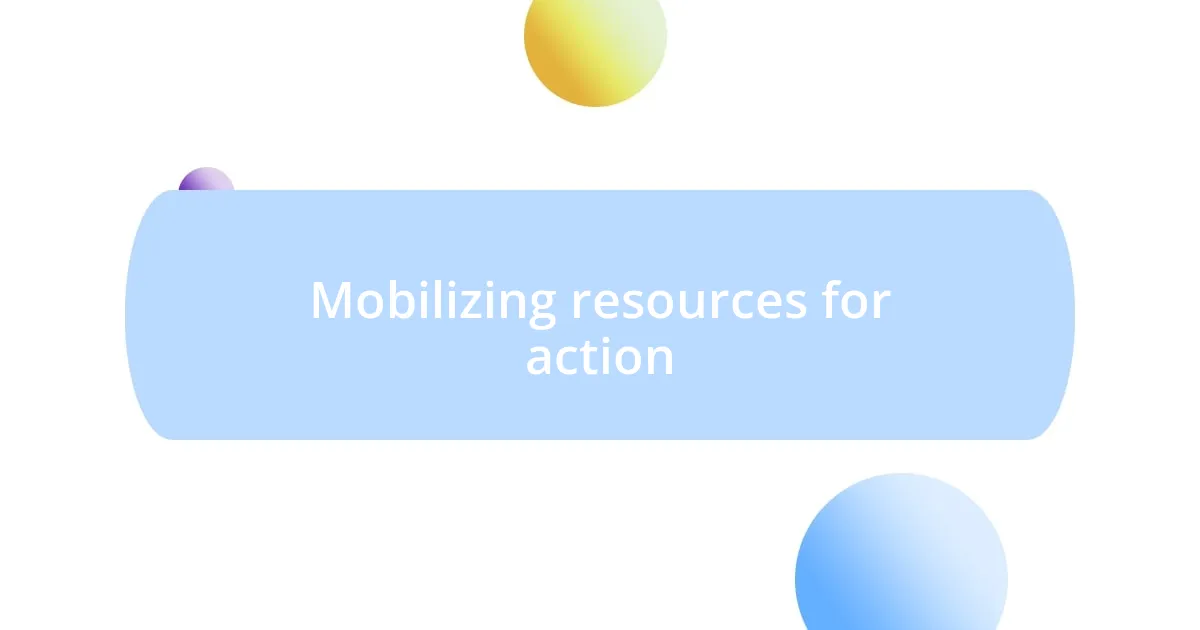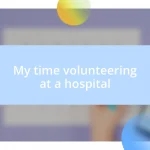Key takeaways:
- Community organizing centers on collective action and empowerment, allowing individuals to share their voices and experiences.
- Key principles include building relationships for trust, ensuring inclusivity for diverse perspectives, and promoting self-education to empower community members.
- Effective communication relies on clarity, active listening, and storytelling to foster connections and encourage open dialogue.
- Evaluating the impact of organizing involves assessing both immediate results and long-term relationships, highlighting the importance of nurturing connections for sustainable community engagement.

Understanding community organizing
Community organizing is fundamentally about bringing people together to create collective action for shared goals. I remember my early days of organizing when standing in a circle, listening to the stories of neighbors, really struck me. Their emotions, hopes, and challenges shaped the essence of what we were trying to achieve—together. Isn’t it powerful to think how personal experiences can drive community?
At its core, community organizing empowers individuals to harness their voices. I once worked alongside a group of reluctant participants and saw how, as they began to share their ideas, a sense of ownership blossomed. It made me realize that engaging people means tapping into their passions and, often, their frustrations. What are we if not a sum of our experiences?
Additionally, there’s an art to understanding different viewpoints within a community. I remember attending a local meeting where tensions were high between various factions. It taught me that listening—truly listening—builds trust and fosters collaboration. Have you ever felt stuck trying to navigate conflicting ideas? That experience cemented my belief in dialogue as a cornerstone of effective community organizing.

Key principles of community organizing
When I think about the key principles of community organizing, one of the most vital is the importance of building relationships. I remember a specific day when a small group gathered to discuss local issues. By sharing a meal together before diving into serious discussions, we created an environment that fostered trust and open communication. That sense of connection made it easier to address sensitive topics, reinforcing my belief that relationships form the backbone of successful organizing.
Another principle that has greatly influenced my journey is inclusivity. There was a particular initiative I worked on that aimed to bring diverse voices to the table. It was challenging but rewarding to ensure that everyone felt heard. Witnessing the transformation when marginalized voices were included was profound. It became clear that when we include everyone, we create a richer, more nuanced approach to problem-solving.
Additionally, self-education within the community stands out as crucial. During one project, I led workshops that equipped participants with skills to articulate their concerns. Watching people grow in confidence and assert their needs was unforgettable. It’s empowering to see individuals evolve into advocates for their communities, reminding me that knowledge truly is power.
| Principle | Description |
|---|---|
| Building Relationships | Creating a foundation of trust through genuine connections. |
| Inclusivity | Ensuring all voices, especially marginalized ones, are included in the dialogue. |
| Self-Education | Empowering individuals to learn and articulate their community’s needs. |

Building relationships with community members
Building relationships with community members is a transformative experience. One evening, I recall staying late at a neighborhood community center, participating in a lively discussion with locals about pressing issues. Sharing laughter, stories, and snacks allowed us to break down barriers that often exist between strangers. Those moments of connection showed me that trust isn’t built overnight; it’s nurtured through shared experiences and mutual respect.
- Empathy Is Key: Each person’s story is a thread in the community’s fabric. Listening and validating their experiences strengthens our bonds.
- Small Gestures Matter: A simple “thank you” or remembering someone’s name can go a long way in signaling sincerity.
- Networking Opportunities: Building relationships opens up doors to collaborate with local businesses and institutions, adding depth to our initiatives.
I’ve learned that true connection often happens outside formal settings. Attending a weekend potluck not only filled my stomach but also my heart. Engaging in informal gatherings like these transcends the usual organizational meetings. It allows us to see one another as people first, fostering a sense of belonging that translates into energized advocacy.

Strategies for effective communication
Effective communication in community organizing is all about clarity and sincerity. I always make it a priority to speak in a way that’s straightforward and relatable. For instance, during a campaign meeting, I noticed that using simple, everyday language helped attendees better understand the issues we faced. It’s the little things that matter: are we really listening to each other, or just waiting for our turn to speak? This question often resonates with me.
Another strategy I’ve found essential is active listening. There was a moment when a fellow organizer was sharing their frustrations about the lack of resources. Rather than jumping in with solutions, I paused and asked a follow-up question that showed I was genuinely interested in their perspective. This not only validated their feelings but also encouraged others to share openly. Have you ever felt unheard in a conversation? I know I have, and it’s a feeling I strive to eliminate amongst my peers.
Lastly, I’ve learned the power of storytelling. One of my most memorable experiences was when a resident shared their personal journey at a community forum. Their vulnerability resonated with the audience and sparked deeper discussions. This taught me that stories can bridge gaps and inspire action. How can we harness the power of stories in our own efforts? I believe that by incorporating personal narratives into our dialogues, we create connections that can drive meaningful change.

Mobilizing resources for action
Mobilizing resources for action requires creativity and a willingness to tap into the strengths of those around us. I remember a time when our community faced an urgent need for supplies for a local shelter. Instead of scrambling for funding, we organized a friendly neighborhood drive, transforming our social connections into tangible resources. The thrill of seeing neighbors rally together with bags of clothes, food, and toiletries was a powerful reminder of what can be achieved when we unite our efforts for a common cause.
As much as physical resources are essential, I believe human connections often hold unparalleled value. One night, while discussing community needs over coffee with a friend, I discovered her ties to a local business that donated generously. It hit me then: mobilizing resources isn’t just about asking for help; it’s about sharing our networks and leveraging our relationships. Have you ever considered how your personal connections could impact community needs? I found that even the smallest relationships can lead to unexpected partnerships, expanding our reach in ways we hadn’t imagined.
In my experience, understanding the diverse skills within your community can be a game changer. During a planning meeting, I was struck by how many talents went unrecognized. From graphic designers to social media savvy teens, everyone had something to offer. It reminded me that mobilizing resources isn’t just about funds or goods; it’s about harnessing the collective abilities that lie within our community. By encouraging people to share their unique gifts, we can create a more vibrant and effective collective action. What unique talent do you possess that might benefit your community? It’s often the skills we take for granted that can ignite real change.

Evaluating the impact of organizing
Evaluating the impact of organizing can often feel like trying to catch smoke with your bare hands—tangible yet elusive. One particular experience I had with a neighborhood clean-up initiative vividly comes to mind. After the event, we conducted a survey to gauge community sentiment and participation. The feedback was overwhelmingly positive, not only regarding the clean-up but also noting a newfound sense of ownership among residents. It’s incredible how small actions can lead to profound feelings of pride and responsibility within a community.
Looking deeper, I recognized that the impact isn’t just about immediate results; it’s about long-term relationships. In my organizing journey, I found that community meetings evolved into supportive spaces where people began sharing their own stories and concerns. I vividly recall a woman who initially came just to participate but ended up leading a group focused on youth mentorship. This transformation illustrated how organizing fosters leadership and empowerment. Isn’t it fascinating how one event can spiral into ongoing community engagement?
I’ve also learned that the changes we initiate can ripple through generations. Reflecting on our intergenerational workshops, I was inspired by the bond that formed between older participants and local youth. Together, they created a garden that became a source of food and knowledge, where the young learned from the wisdom of the elders. Evaluating the impact of such initiatives is not just about numbers—it’s about the deep-rooted connections that form, creating a culture of collaboration. How do we ensure these connections endure beyond our organizing efforts? I believe it comes down to nurturing relationships and celebrating the shared victories that come from community spirit.

Lessons learned for future organizing
When planning future organizing efforts, I’ve learned that flexibility is crucial. I can recall a time when we had scheduled a community health fair, only to face unexpected rain. Instead of giving up, we quickly relocated to a nearby community center, which turned out to be a blessing in disguise. The indoor space allowed us to engage more deeply with attendees, and we ended up having valuable conversations that we wouldn’t have had outside. Have you ever had to pivot unexpectedly? It’s moments like these that teach us to embrace change as part of the process.
Another lesson that resonated with me is the importance of clear communication. I remember when we organized our first neighborhood meeting; confusion about the agenda created tension among participants. To remedy this, I started using simple visual aids and summaries to keep everyone on the same page. The difference was palpable—people felt informed and empowered to speak up. Are we doing enough to ensure everyone is heard? I believe that when we prioritize clarity, we foster a sense of belonging and involvement.
Lastly, I’ve realized that celebrating small wins can create momentum for future efforts. During one project, we set milestones and took time to recognize each achievement, no matter how minor. I found that this not only motivated the team but also strengthened our bond. It felt good to acknowledge our progress together. How can we make success a shared experience? By highlighting our collective victories, we build a culture that thrives on encouragement and collaboration, paving the way for even greater accomplishments ahead.














